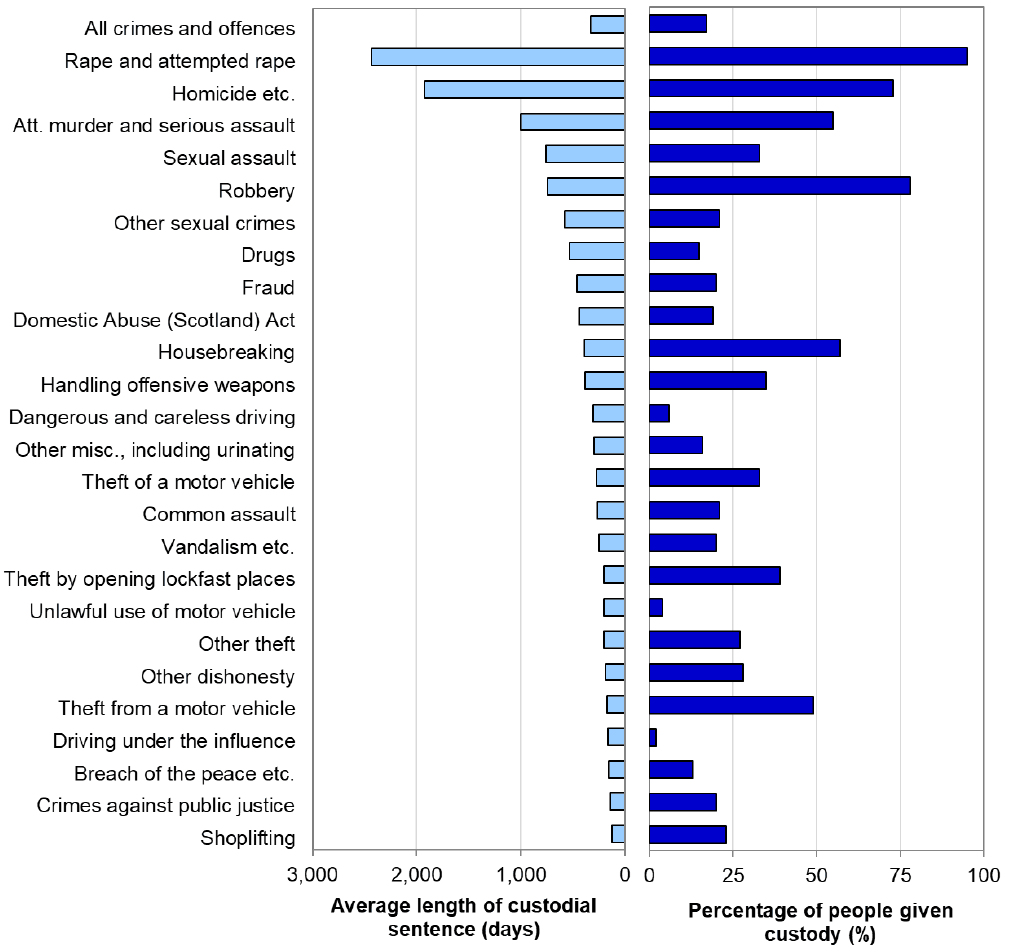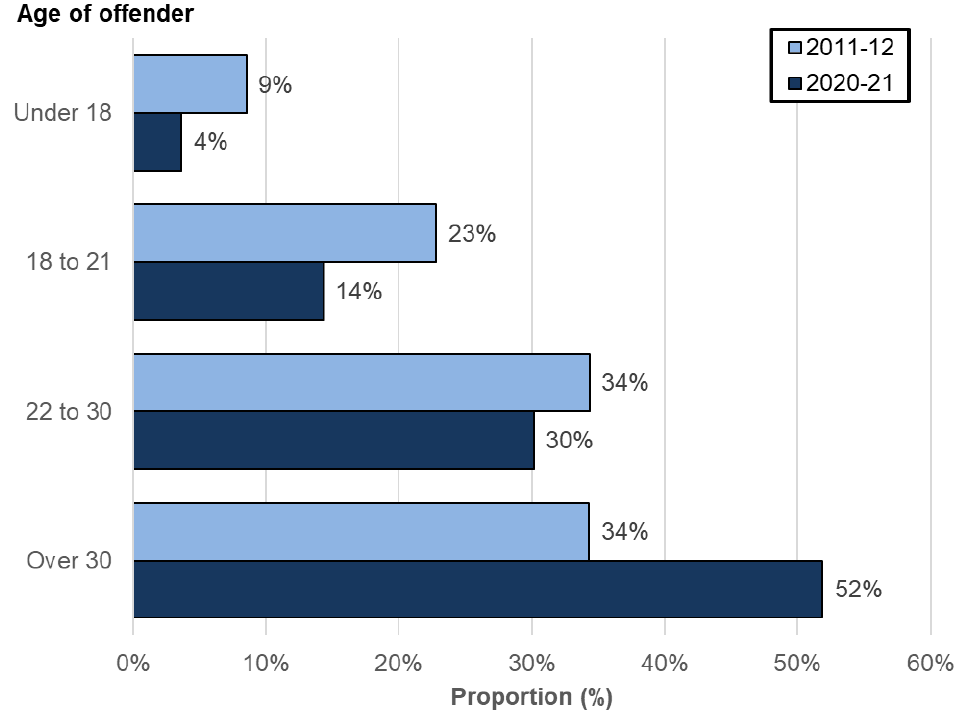Criminal proceedings in Scotland: 2020-2021
Statistics on criminal proceedings concluded in Scottish courts and alternative measures to prosecution issued by the police and the Crown Office and Procurator Fiscal Service are presented for the ten years from 2011-12 to 2020-21. The latest year’s data is impacted by the COVID-19 pandemic.
10. Custodial sentences by type of crime
(Tables 9 and 10a-d)
Custodial sentences for non-sexual crimes of violence
Homicide comprises murder, culpable homicide (i.e. unlawful killing but without intent to do so) and the statutory crimes of causing death by dangerous or careless driving, causing death by careless driving when under the influence of drink or drugs, driving illegally when involved in a fatal accident and corporate homicide.
Seventy-three percent, or 35 of the 48 people convicted of homicide in 2020-21 were given a custodial sentence, a ten percentage-point decrease on the 2019-20 figure of 83%. During the period from 2011-12 to 2020-21, the proportion of homicide convictions receiving custodial sentences has ranged between 69% and 88%. Causing death by careless driving crimes are more likely to receive non-custodial sentences than other types of homicide. In 2020-21, 23% of homicide convictions were for death by careless driving, but 77% of non-custodial sentences for homicide were for death by careless driving.
Forty percent of custodial sentences for homicide were life sentences imposed for murder (14 people), a decrease compared to 2019-20 (82%, 41 people). The remainder (21 people), who were convicted for other types of homicide, were given an average sentence of around five years and three months (1,923 days), around a year (374 days) less than in 2019-20 (2,297 days), and at the lower end of the range seen over the last decade (1,913 to 2,392 days).
The average sentence length for crimes under the Domestic Abuse (Scotland) Act was around a year and two and a half months (438 days) in 2020-21.
Changes in average custodial sentence lengths for other non-sexual crimes of violence between 2019-20 and 2020-21 are as follows:
- An decrease of 7% (down 75 days) for attempted murder and serious assault (an average of 998 days given in 2020-21);
- A similar average sentence length for robbery (down 3 days, to 746 days); and
- An decrease of 11% for other non-sexual crimes of violence, (down by 119 to 952 days).
Custodial sentences for sexual crimes
As shown in Chart 10, custody was the most frequently used disposal for “rape and attempted rape”, being imposed on 95% of people with a charge proven. Custodial sentences for “rape and attempted rape” attracted the longest average custodial sentence of all crime types (other than life sentences for murder, which are excluded from the homicide category in the chart). The average sentence length for this kind of crime decreased slightly in 2020-21, down 10 days (0.4%) from last year to 2,435 days (six years and 8 months). The average sentence for rape and attempted rape has ranged between 2,264 days and 2,655 days over the last ten years.
Sexual assault sentences were, on average, 247 days (25%) shorter than in 2019-20, decreasing to 761 days (around 2 years and 1 month) in 2020-21. This is the lowest average sentence for this crime in the last ten years.

Notes for Chart 10
Note 1. Excludes crime types where the number of people sentenced to prison is fewer than 30.
Custodial sentences for crimes of dishonesty
Twenty nine percent of convictions for crimes of dishonesty received a custodial sentence in 2020-21, a decrease from 31% in 2019-20, and the lowest proportion of custodial sentences issued for this crime type in the past ten years. Overall, the average custodial sentence length for crimes of dishonesty increased from 208 days in 2019-20 to 219 days in 2020-21; an increase of 5%. This is the longest average sentence length seen in the past ten years, and 33% higher than the average in 2011-12 (165 days). The increase in the average length of custodial sentence for Crimes of dishonesty is mostly driven by an increase in average sentence length for Fraud crimes, which has more than doubled over the ten year period from around 7 months (220 days) in 2011-12 to around 1 year and 3 months (464 days) in 2020-21. Average sentence length for Fraud saw one of the biggest increases for all crime types over the past year, increasing by 62% (from 287 days in 2019-20).
Around 57% of housebreaking convictions received custodial sentences in 2020-21, down three percentage points from 60% in 2019-20. In 2020-21, the average custodial sentence for housebreaking was just over a year (388 days), a 70 day (15%) decrease from 458 days in 2019-20.
Custodial sentences for handling offensive weapons
Sections 47 and 49 of the Criminal Law (Consolidation) (Scotland) Act 1995 make provision for the offences of:
- Carrying offensive weapons;
- Having in a public place an article with a blade or point.
- These two offences make up the crime group “handling offensive weapons”, statistics for which are presented in the standard tables accompanying this publication. As shown in the additional table accompanying this bulletin, there were 1,207 people convicted of “handling offensive weapons” in 2020-21, of which two-thirds (66%) were for carrying knives i.e. “having in a public place an article with a blade or point” (792 convictions). Compared to last year these changes represent decreases for both categories; down 31% for the total of “handling offensive weapons” and down 29% specifically for carrying knives. The remainder of offensive weapons convictions related to crimes for other weapons such as baseball bats, bottles and pieces of wood; this crime type saw an increase of 27% over the past year although the numbers are small, increasing from 22 in 2019-20 to 28 in 2020-21 Firearm offences are not included in the “handling offensive weapons” category but are included within “other miscellaneous offences”.
Statistics for carrying knives are not published within the standard tables accompanying this bulletin but are presented as an additional table alongside trends for all “handling offensive weapons” for the last ten years.
The proportion of convictions for handling offensive weapons which received a custodial sentence remained the same over the year at 35% in 2020-21, but was one percentage point lower than in 2011-12. The proportion of custodial sentences given specifically for knife offences decreased in the past year by three percentage points from 38% to 35% in 2020-21, and also decreased by nine percentage points since 2011-12 (from 44%).
As seen in Chart 11 below, there has been a shift in the age profile of persons being convicted for handling offensive weapons since 2011-12. In 2011-12, 34% of convictions were in the over-30s group, and 32% were for people under 22 years of age. We now see more than half (52%) of all offensive weapon convictions in the over 30s, and under a fifth (18%) for those aged under 22, 4% being for under-18s.
The average custodial sentence length for handling offensive weapons is 22% higher than it was in 2011-12, increasing from 312 days in 2011-12 to 381 days in 2020-21. The figure in 2020-21 was also 2% higher than the average sentence length of 375 days in 2019-20. The trend over the last ten years is broadly similar for knife offences only, with the average custodial sentence length being 4% longer than that of all handling offensive weapons at 397 days in 2020-21.

Contact
Email: justice_analysts@gov.scot
There is a problem
Thanks for your feedback